Know the adage that defense wins championships? Well, we’ll take half a sack, please. Balance wins championships more.
Yet as we shall see soon, an elite D can remove a lot of warts, turn an average team into a good one or even a good team into a great one on occasion.
Here is the best defense for each franchise in the expansion era, and to make things even more interesting, we ranked them.
The criteria was a combination of historical achievement, statistical data, metrics, strength of schedule, the Simple Rating System (courtesy of Pro Football Reference) and the eye test, not necessarily in that order.
Defenses with Super Bowl pedigrees received bumps in the order. In a few cases, they made the cut over ones that performed better in the regular season.
Note: All stats are per-game averages.
32. 2011 Houston Texans
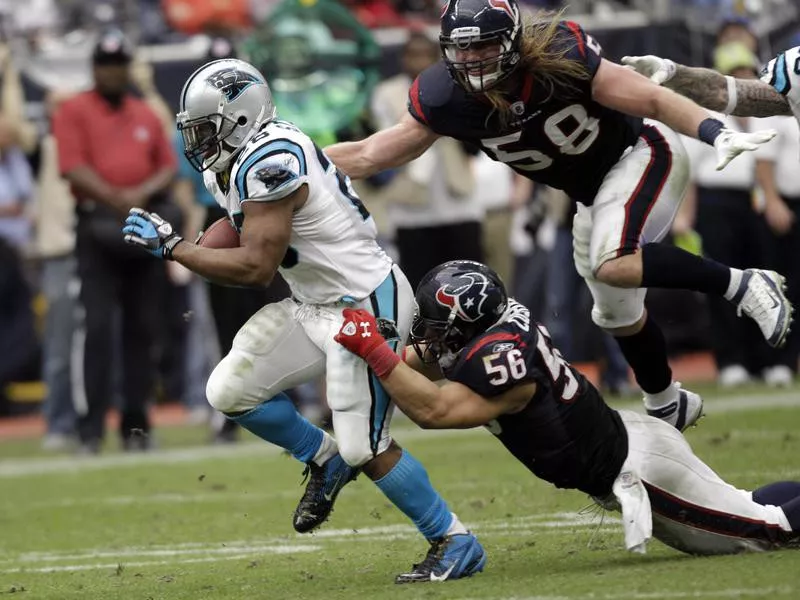
You’re not going anywhere. David J. Phillip / AP Photo
Record: 10-6 (first, AFC South)
Points allowed: 17.4 (fourth)
Total yards allowed: 229.8 (first)
Rush yards allowed: 87.9 (first)
Pass yards allowed: 141.9 (third)
Sacks: 4.1 (first)
Takeaways: 3.4 (third)
Coordinator: Wade Phillips
Notable players: Linebacker Brian Cushing, cornerback Johnathan Joseph, ends Antoine Smith and J.J. Watt
Finish: Lost to Baltimore Ravens 20-13 in divisional round
Bottom line: A dominant pass rush was the hallmark of this unit, which was consistent across the board.
This won’t be the last time you see a Wade Phillips-coached defense on this list.
31. 2014 Arizona Cardinals
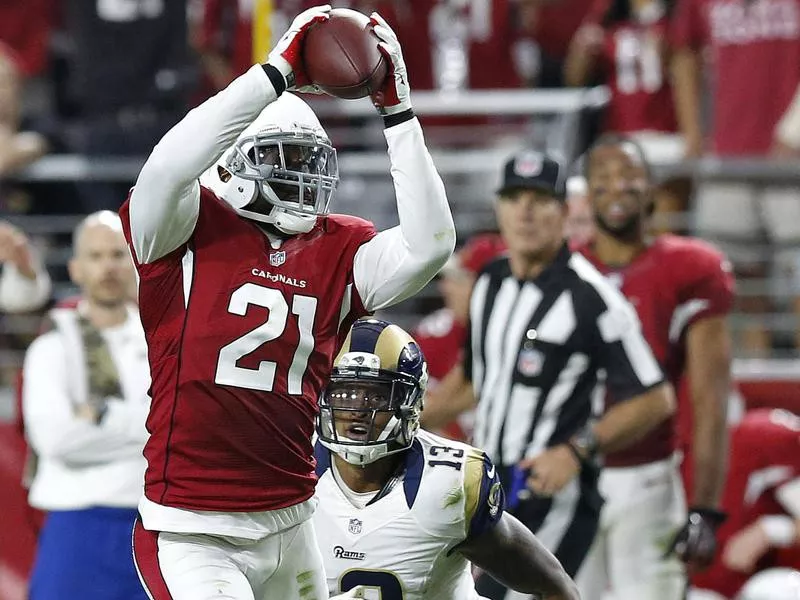
Thanks for that. Ross D. Franklin / AP Photo
Record: 11-5 (second, NFC West)
Points allowed: 18.7 (fifth)
Total yards allowed: 368.2 (24th)
Rush yards allowed: 108.7 (13th)
Pass yards allowed: 259.5 (29th)
Sacks: 2.2 (24th)
Takeaways: 1.6 (14th)
Coordinator: Todd Bowles
Notable players: End Calais Campbell, linebacker Larry Foote, cornerbacks Antonio Cromartie and Patrick Peterson
Finish: Lost to Carolina Panthers 27-16 in wild-card round
Bottom line: Their basic numbers don’t begin to tell the story.
This is the hidden one that matters — third in red-zone percentage (43.9) in the league.
That’s the definition of bend but don’t break, kids.
30. 1979 San Diego Chargers
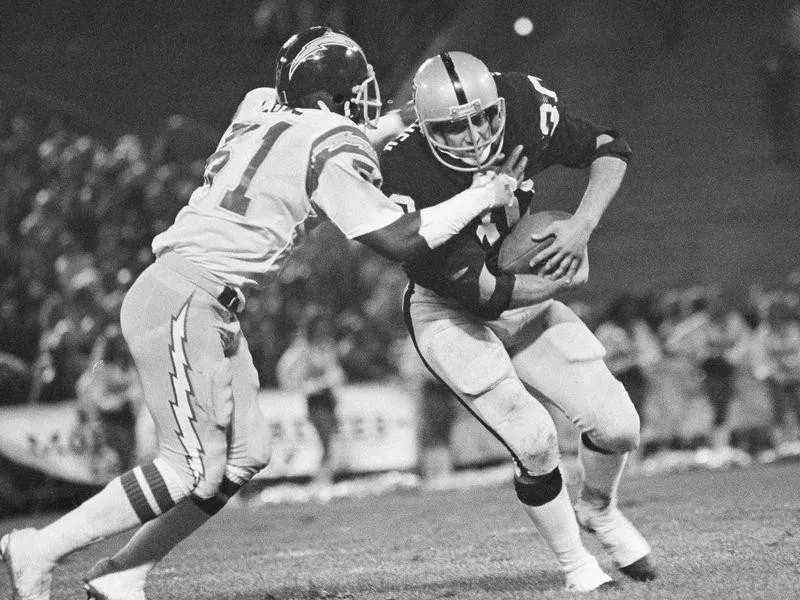
Underrated. AP Photo
Record: 12-4 (first, AFC West)
Points allowed/game: 15.4 (second)
Total yards allowed/game: 278.5 (fifth)
Rush yards allowed/game: 119.2 (eighth)
Pass yards allowed/game: 159.3 (seventh)
Sacks/game: 2.6 (11th)
Takeaways/game: 2.9 (third)
Coordinator: Jackie Simpson
Notable players: End Fred Dean, tackle Gary Johnson, linebackers Woodrow Lowe and Ray Preston
Finish: Lost to Houston Oilers 17-14 in divisional round
Bottom line: While the Air Coryell attack hogged the headlines, this big-play defense quietly went about its business.
It thrived on interceptions (28) and fumble recoveries (18).
29. 2015 Cincinnati Bengals
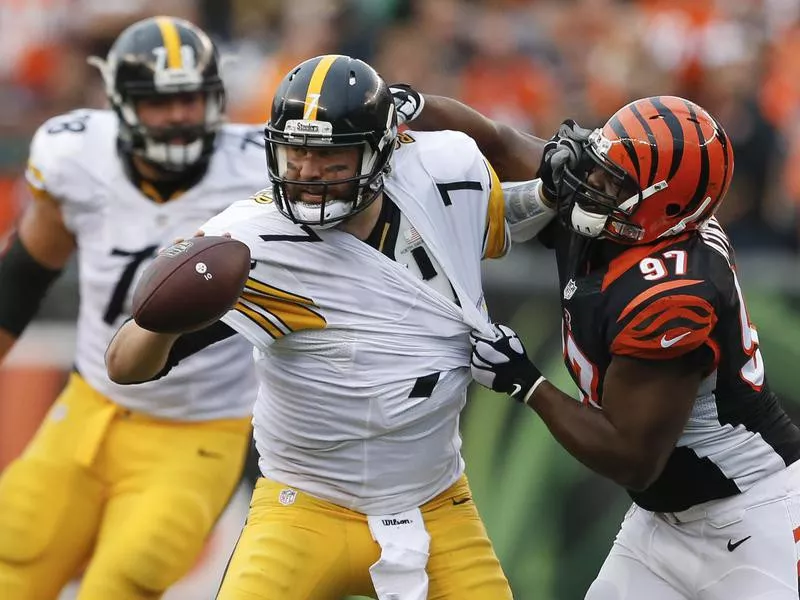
Tiger style. Gary Landers / AP Photo
Record: 12-4 (first, AFC North)
Points allowed: 17.4 (second)
Total yards allowed: 340.8 (11th)
Rush yards allowed: 92.3 (seventh)
Pass yards allowed: 248.5 (20th)
Sacks/game: 2.7 (10th)
Takeaways: 1.75 (sixth)
Coordinator: Paul Guenther
Notable players: Tackle Geno Atkins, end Carlos Dunlap, cornerback Adam Jones, safety Reggie Nelson
Finish: Lost to Pittsburgh Steelers 18-16 in wild-card round
Bottom line: This defense was at its best on obvious pass downs, when Carlos Dunlap (13.55 sacks) and Geno Atkins (11.0) could tee off on quarterbacks.
Only four defenses had a higher red-zone percentage (47.4) than the Bengals.
28. 1994 Cleveland Browns
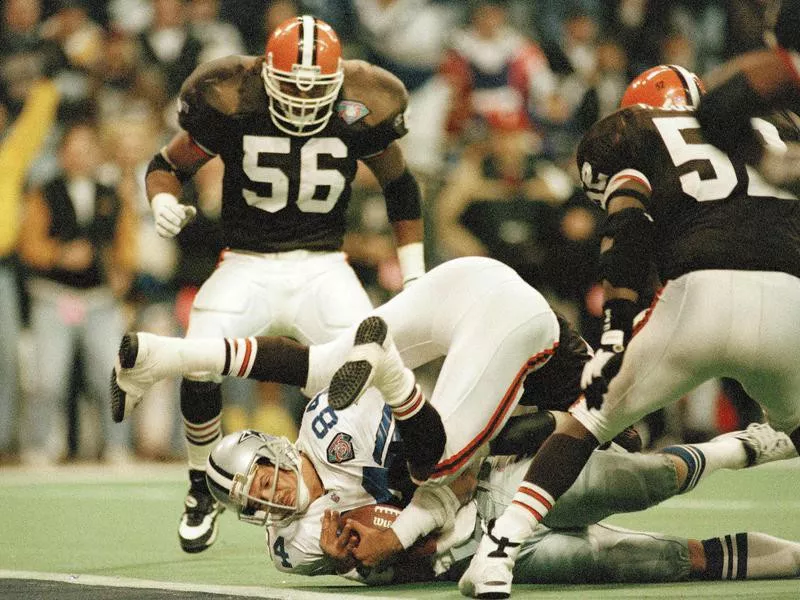
Stop right there. Eric Gay / AP Photo
Record: 11-5 (second, AFC Central)
Points allowed: 12.75 (first)
Total yards allowed: 301.6 (seventh)
Rush yards allowed: 104.3 (13th)
Pass yards allowed: 197.3 (seventh)
Sacks: 2.4 (seventh)
Takeaways: 1.9 (13th)
Coordinator: Nick Saban
Notable players: End Rob Burnett, linebacker Pepper Johnson, tackle Michael Dean Perry, safety Eric Turner
Finish: Lost to Pittsburgh Steelers 29-9 in divisional round
Bottom line: How soon we forget the Bill Belichick legacy started on defense.
The head coach brought in former New York Giants mainstays Pepper Johnson and Carl Banks to stabilize a unit that was consistent, if not flashy.
They allowed 20 points or less in every game except two, playoffs included.
27. 1973 Washington Redskins
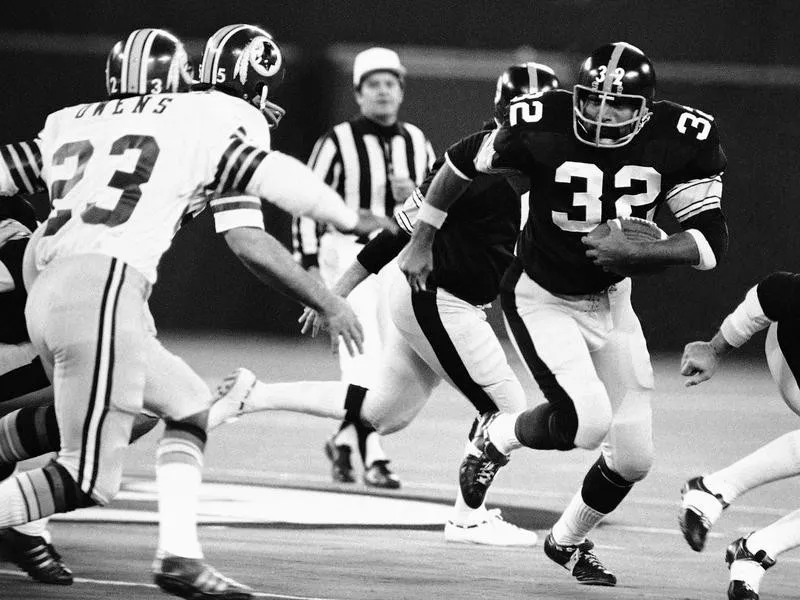
The 1973 Redskins allowed 14.1 points per game. Harry Cabluck / AP Photo
Record: 10-4 (second, NFC East)
Points allowed: 14.1 (sixth)
Total yards allowed: 269.9 (ninth)
Rush yards allowed: 114.5 (fourth)
Pass yards allowed: 155.4 (18th)
Sacks: 3.8 (first)
Takeaways: 3.1 (second)
Coordinator: Greg Manusky
Notable players: End Verlon Biggs, safety Ken Houston, linebackers Chris Hanburger and Dave Robinson
Finish: Lost to Minnesota Vikings 27-20 in divisional round
Bottom line: This was the quintessential George Allen defense — short on youth (a half-dozen starters were 30 or older), long on grit and know-how.
It scored seven touchdowns on interceptions (four), fumbles (two) and a blocked punt.
26. 2004 Jacksonville Jaguars
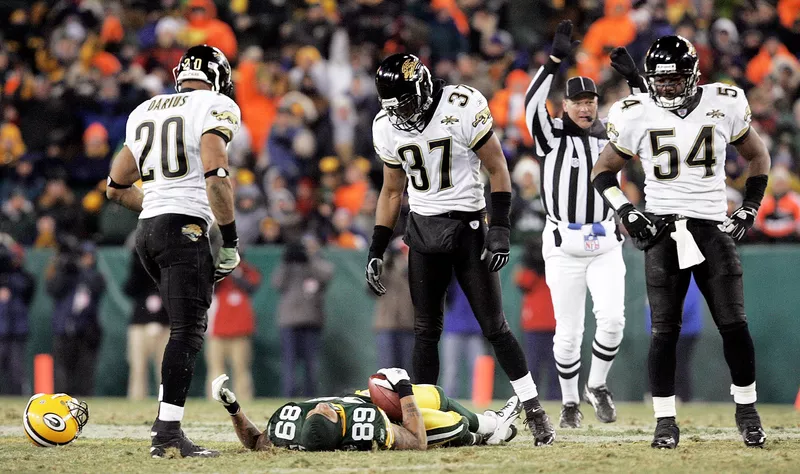
A tough group. Mike Roemer / AP Photo
Record: 9-7 (second, AFC South)
Points allowed: 17.5 (seventh)
Total yards allowed: 320.9 (11th)
Rush yards allowed: 111.1 (11th)
Pass yards allowed: 209.8 (16th)
Sacks: 2.3 (17th)
Takeaways: 1.75 (17th)
Coordinator: Mike Smith
Notable players: Safety Donovin Darius, linebacker Mike Peterson, tackles John Henderson and Marcus Stroud
Finish: Missed playoffs
Bottom line: Head coach-general manager Tom Coughlin built this group from the middle on out through the draft.
There was no tougher D to score against close to the goal line (38.3 red-zone percentage).
25. 1977 Atlanta Falcons
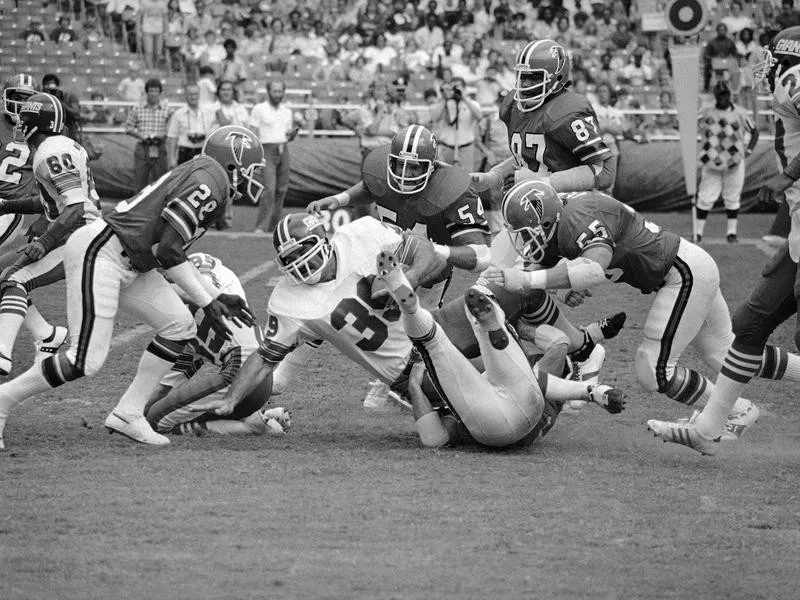
Swarm the ballcarrier. AP Photo
Record: 7-7 (second, NFC West)
Points allowed: 9.2 (first)
Total yards allowed: 231.6 (second)
Rush yards allowed: 132.7 (11th)
Pass yards allowed: 98.9 (first)
Sacks: 3.0 (seventh)
Takeaways: 3.4 (second)
Defensive assistant: Jerry Glanville
Notable players: Linebacker Greg Brezina, safety Ray Brown, end Claude Humphrey, cornerback Rolland Lawrence
Finish: Missed playoffs
Bottom line: What — you never heard of the “Gritz Blitz”? You’re not alone.
Other than Claude Humphrey, who was a one-man pass rush, this historic D lacked name recognition.
But if points allowed is the criteria, then this is the greatest defense of the expansion era. None allowed fewer in a 14-game season.
24. 2009 Dallas Cowboys
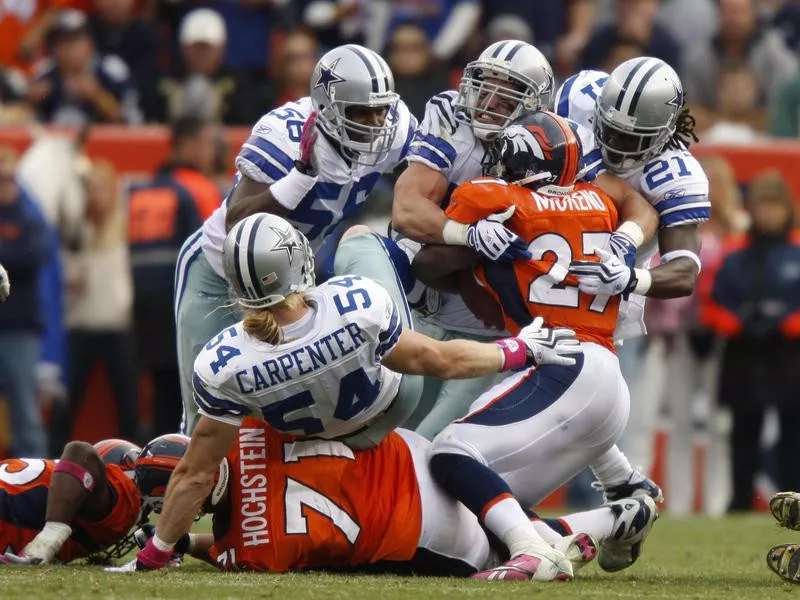
Team effort. Jack Dempsey / AP Photo
Record: 11-5 (first, NFC East)
Points allowed: 15.6 (second)
Total yards allowed: 315.9 (ninth)
Rush yards allowed: 90.5 (fourth)
Pass yards allowed: 225.4 (20th)
Sacks: 2.6 (seventh)
Takeaways: 1.3 (27th)
Coordinator: Brian Stewart
Notable players: Nose tackle Jay Ratliff, linebacker DeMarcus Ware, cornerbacks Mike Jenkins and Terence Newman
Finish: Lost to Minnesota Vikings 34-3 in divisional round
Bottom line: This group was remarkably consistent until the bitter end.
The Brett Favre-to-Sidney Rice combo lit them up for three touchdowns in a 34-3 rout in the divisional playoff round.
After that, defensive coordinator Brian Stewart received a pink slip as a lovely parting gift.
23. 1973 Oakland Raiders
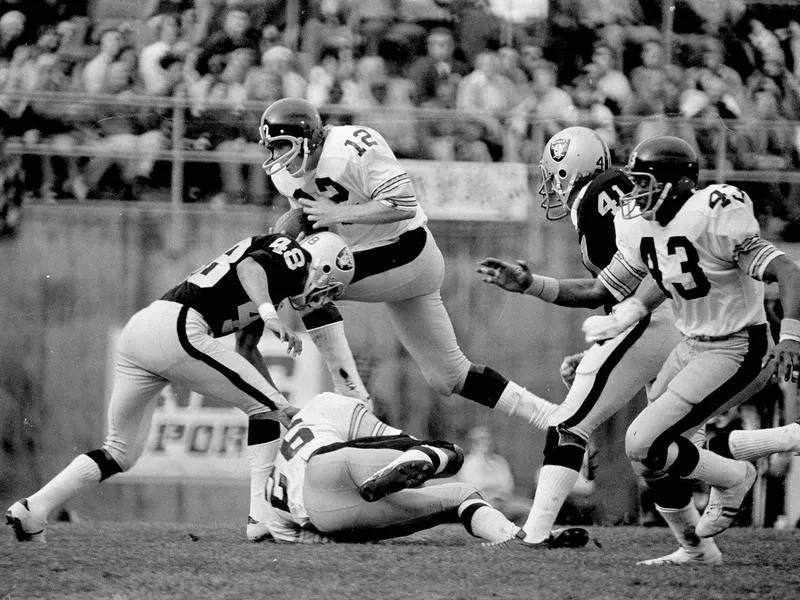
Commitment to beating down opponents. AP Photo
Record: 9-4-1 (first, AFC West)
Points allowed: 12.5 (third)
Total yards allowed: 225.7 (second)
Rush yards allowed: 105.0 (second)
Pass yards allowed: 120.7 (eighth)
Sacks: 2.9 (fifth)
Takeaways: 2.4 (12th)
Coordinator: Head coach John Madden
Notable players: Cornerback Willie Brown, linebacker Phil Villapiano, safeties George Atkinson and Jack Tatum
Finish: Lost to Miami Dolphins 27-10 in conference championship
Bottom line: The Raiduhs didn’t allow more than 23 points until the final game, when they were rolled by the Miami Dolphins’ power run game in a 27-10 smackdown.
Even more remarkable, they did this with a pair of 30-somethings at cornerback. Nemiah Wilson was the other.
22. 1995 Kansas City Chiefs
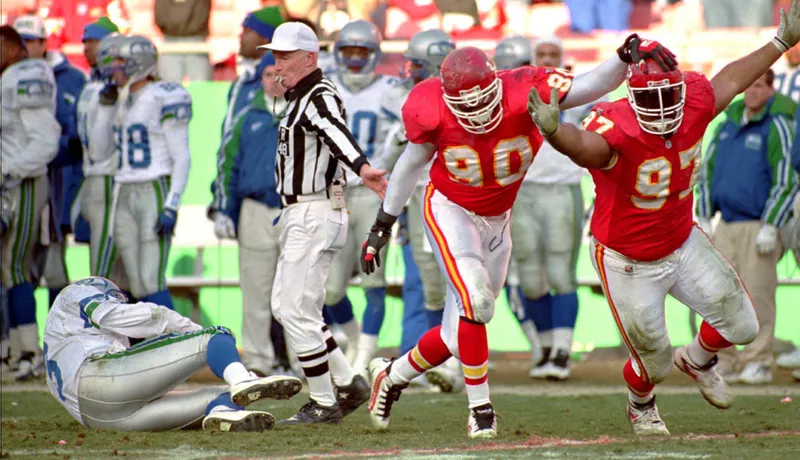
Man down. Joe Ledford / AP Photo
Record: 13-3 (first, AFC West)
Points allowed: 15.1 (first)
Total yards allowed: 284.3 (second)
Rush yards allowed: 82.9 (third)
Pass yards allowed: 201.4 (fifth)
Sacks: 2.9 (third)
Takeaways: 2.1 (12th)
Notable players: Cornerback Dale Carter, tackle Dan Saleaumua, end Neil Smith, linebacker Derrick Thomas
Coordinator: Gunther Cunningham
Finish: Lost to Indianapolis Colts 10-7 in divisional round
Bottom line: This star-studded cast got better as the season progressed — opponents averaged a mere 12.2 points in the final nine games.
They did their parts against the Indianapolis Colts in the divisional round, only to fall short in a 10-7 gut-wrencher at home.
Two luckless words. Marty Schottenheimer.
21. 1992 New Orleans Saints
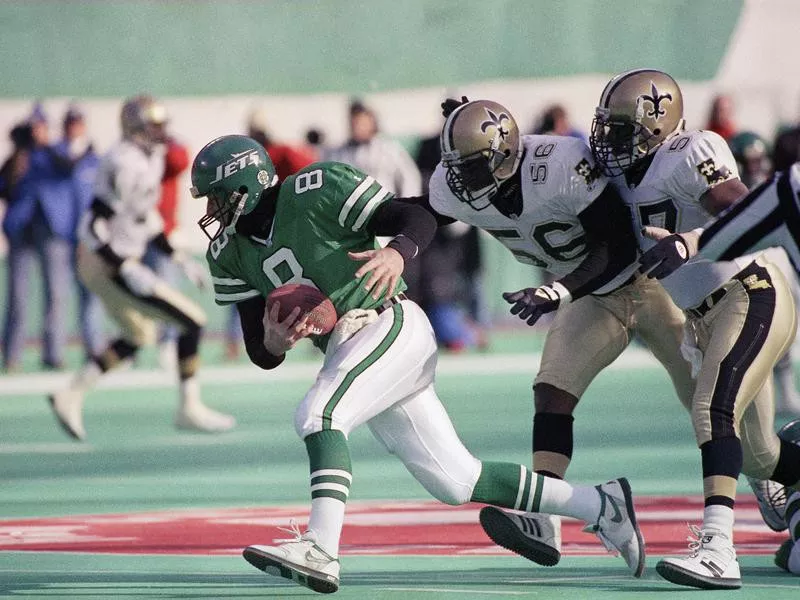
Come back here. Bill Kostroun / AP Photo
Record: 12-4 (second, NFC West)
Points allowed: 12.6 (first)
Total yards allowed: 254.7 (second)
Rush yards allowed: 100.3 (seventh)
Pass yards allowed: 154.4 (first)
Sacks: 3.6 (first)
Takeaways: 2.4 (fifth)
Coordinator: Steve Sidwell
Notable players: Linebackers Rickey Jackson, Vaughan Johnson and Sam Mills and Pat Swilling
Finish: Lost to Philadelphia Eagles 36-20 in wild-card round
Bottom line: This defense boasted four Pro Bowl linebackers and ranked high in every major category.
It also had a fatal flaw that the Philadelphia Eagles exploited in a 36-20 loss in the wild-card playoffs, where a so-so secondary was burned on two long touchdown passes.
20. 1999 Buffalo Bills
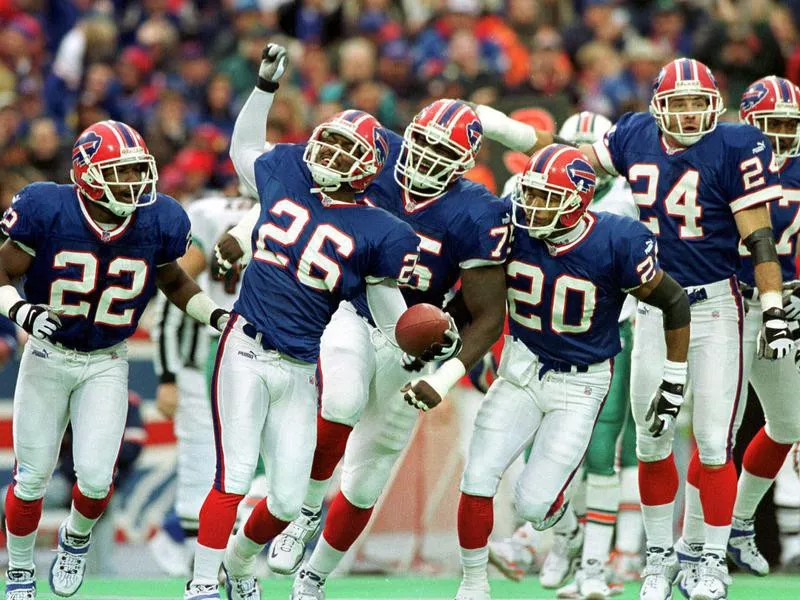
All for one and one for all. Mike Groll / AP Photo
Record: 11-5 (second, AFC East)
Points allowed: 14.3 (second)
Total yards allowed: 252.8 (first)
Rush yards allowed: 85.6 (fourth)
Pass yards allowed: 167.2 (first)
Sacks: 2.3 (20th)
Takeaways: 1.3 (28th)
Coordinator: Ted Cottrell
Notable players: Linebacker Sam Cowart, safety Kurt Schulz, end Bruce Smith, nose tackle Ted Washington
Finish: Lost to Tennesse Titans 22-16 in wild-card round
Bottom line: Has any great defense overachieved more than this bunch of geezers?
It had no Pro Bowlers, no dominant pass-rusher (Bruce Smith was 36) and no athletic playmakers.
It did have head coach Wade Phillips, though, one of the best defensive minds of his time.
19. 2008 Tennessee Titans
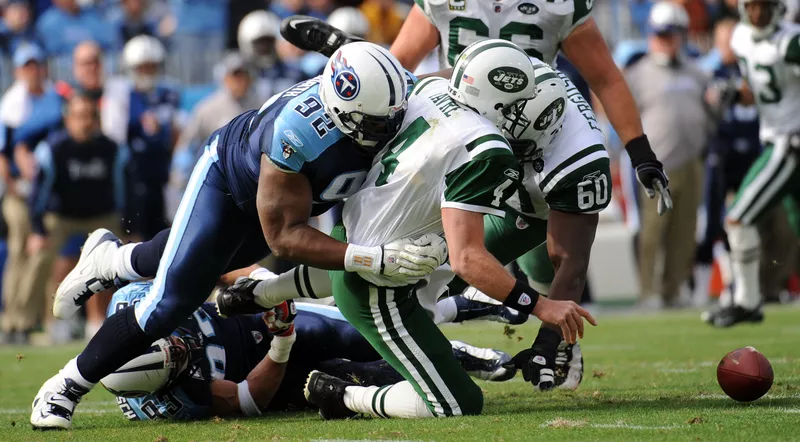
This is going to hurt you more than it’s going to hurt me. John Russell / AP Photo
Record: 13-3 (first, AFC South)
Points allowed: 14.6 (second)
Total yards allowed: 293.6 (seventh)
Rush yards allowed: 93.9 (sixth)
Pass yards allowed: 199.75 (ninth)
Sacks: 2.75 (fifth)
Takeaways: 1.9 (third)
Coordinator: Jim Schwartz
Notable players: Cornerback Courtland Finnegan, tackle Albert Haynesworth, safeties Chris Hope and Michael Griffin
Finish: Lost to Baltimore Ravens 13-10 in divisional round
Bottom line: While Albert Haynesworth wreaked havoc at the line of scrimmage, the secondary allowed few big plays downfield.
This group allowed more than 17 points only three times, which included a 13-10 loss to the Baltimore Ravens in the playoffs.
They deserved better.
18. 2009 New York Jets
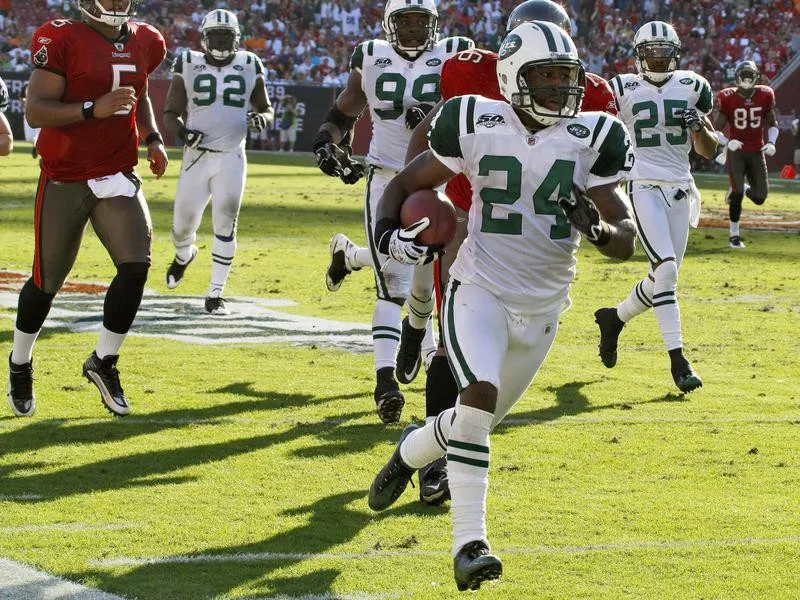
Do not test us. Chris O’Meara / AP Photo
Record: 9-7 (second, AFC East)
Points allowed: 14.75 (second)
Total yards allowed: 252.3 (first)
Rush yards allowed: 98.6 (eighth)
Pass yards allowed: 153.7 (first)
Sacks: 2.0 (18th)
Takeaways: 1.9 (eighth)
Coordinator: Mike Pettine
Notable players: End Shaun Ellis, linebacker David Harris, tackle Sione Pouha, cornerback Darrelle Revis
Finish: Lost to Indianapolis Colts 30-17 in conference championship
Bottom line: So crazy good was Darrelle Revis this season, opponents virtually ignored his side of the field.
The J-E-T-S Jets-Jets-Jets allowed 17 points or less in 13 games and got to within one victory of a Super Bowl berth.
But it wasn’t meant to be.
17. 2012 San Francisco 49ers
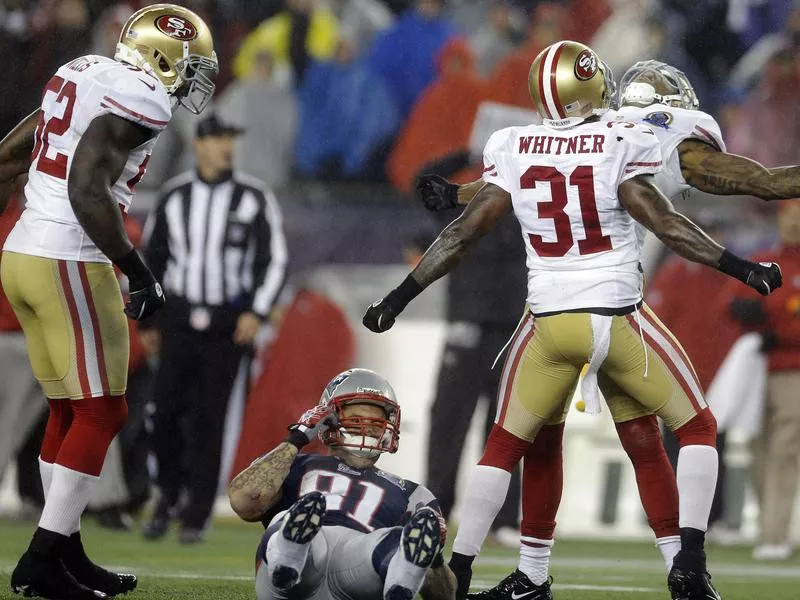
The 2012 49ers defense left many opponents dazed and confused. Elise Amendola / AP Photo
Record: 11-4-1 (first, NFC West)
Points allowed: 17.1 (second)
Total yards allowed: 294.4 (third)
Rush yards allowed: 94.2 (fourth)
Pass yards allowed: 200.2 (fourth)
Sacks: 2.4 (11th)
Takeaways: 1.6 (14th)
Coordinator: Vic Fangio
Notable players: Safety Dashon Goldson, linebackers NaVorro Bowman, Aldon Smith and Patrick Willis
Finish: Lost to Baltimore Ravens 34-31 in Super Bowl XLVII
Bottom line: Statistically, the 2019 team is better.
But unless it reaches the Super Bowl like this version, we’ll take the one with six Pro Bowlers and four All-Pros on its roster.
Yeah, even if it did spit up 29.7 points per game in the postseason.
16. 1980 Philadelphia Eagles
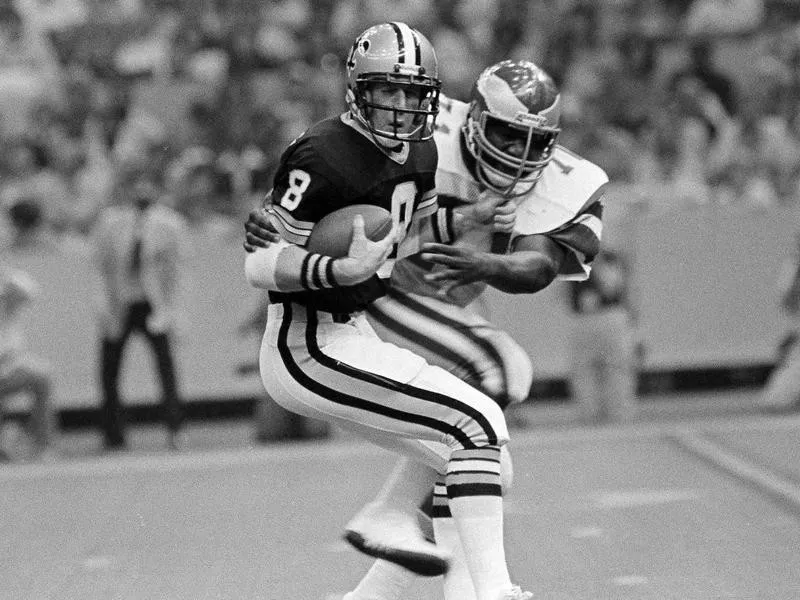
Spin cycle. AP Photo
Record: 12-4 (first, NFC East)
Points allowed: 13.9 (first)
Total yards allowed: 277.7 (second)
Rush yards allowed: 101.1 (second)
Pass yards allowed: 176.6 (fifth)
Sacks: 2.75 (sixth)
Takeaways: 2.2 (15th)
Coordinator: Marion Campbell
Notable players: Tackle Charlie Johnson, safety Randy Logan, linebacker Jerry Robinson, cornerback Roynell Young
Finish: Lost to Oakland Raiders 27-10 in Super Bowl XV
Bottom line: Their 2001 edition was every bit as good, but conference champions receive special treatment here.
They allowed no more than 14 points in each of nine games.
15. 2013 Carolina Panthers
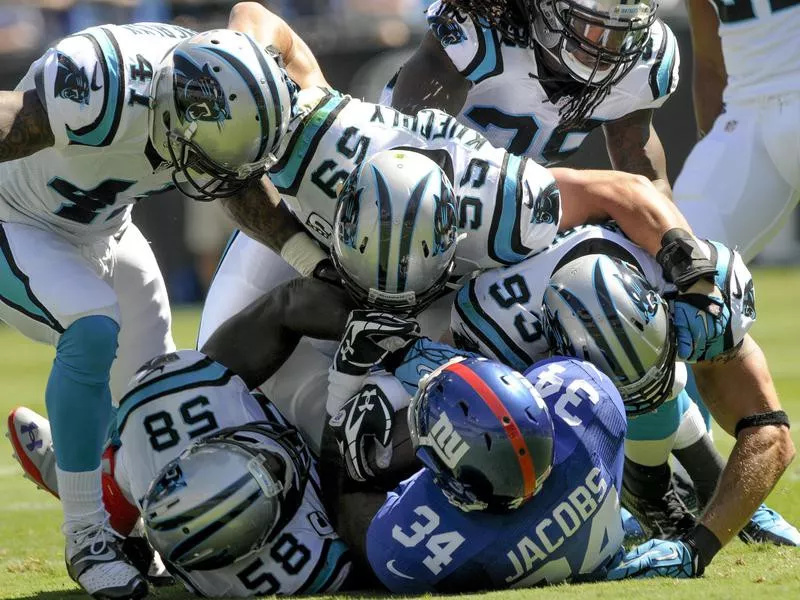
Welcome to the party. Mike McCarn / AP Photo
Record: 12-4 (first, NFC South)
Points allowed: 15.1 (second)
Total yards allowed: 301.3 (second)
Rush yards allowed: 86.9 (second)
Pass yards allowed: 214.3 (sixth)
Sacks: 3.75 (first)
Takeaways: 1.9 (sixth)
Coordinator: Sean McDermott
Notable players: End Greg Hardy, tackle Star Lotulelei, linebackers Thomas Davis and Luke Kuechly
Finish: Lost to San Francisco 49ers 23-10 in divisional round
Bottom line: What this bunch lacked in star power, they made up for in depth and consistency.
Eight players had three sacks or more.
Only three opponents scored more than 20 points in a game.
14. 1975 Los Angeles Rams
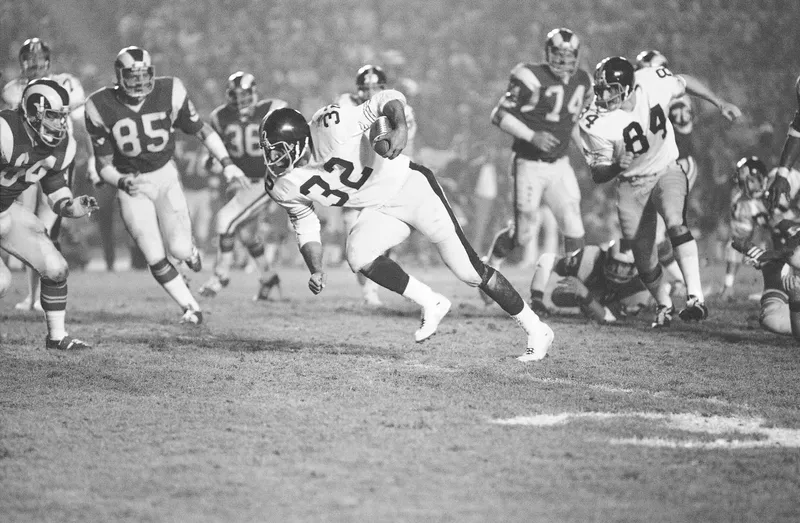
Pursuit. AP Photo
Record: 12-2 (first, NFC West)
Points allowed: 9.6 (first)
Total yards allowed: 237.3 (second)
Rush yards allowed: 109.5 (second)
Pass yards allowed: 127.8 (third)
Sacks: 3.1 (fifth)
Takeaways: 2.9 (11th)
Coordinator: Ray Malavasi
Notable players: Tackle Merlin Olsen, linebacker Isiah Robertson, ends Fred Dryer and Jack Youngblood
Finish: Lost to Dallas Cowboys 37-7 in conference championship
Bottom line: A ferocious defense that boasted five Pro Bowlers was poised to be on an even shorter list of best ever.
Then the Dallas Cowboys put up 37 points on a muddy field in the NFC championship game, five more than the Rams had allowed in the final half-dozen regular-season games combined.
Strange game, football.
13. 2019 New England Patriots
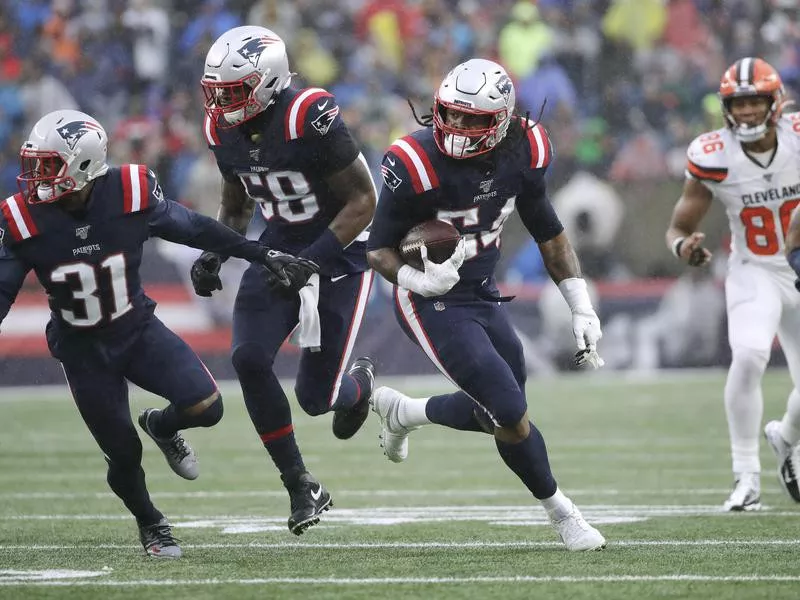
Let’s go, boys. Elise Amendola / AP Photo
Record: 10-3 (first, AFC East)
Points allowed: 12.9 (first)
Total yards allowed: 264.8 (first)
Rush yards allowed: 93.0 (fourth)
Pass yards allowed: 171.8 (second)
Sacks: 3.2 (sixth)
Takeaways: 2.4 (second)
Coordinator: Head coach Bill Belichick
Notable players: End Trey Flowers, cornerback Stephon Gilmore, linebackers Dont’a Hightower and Kyle Van Noy
Finish: N/A
Bottom line: How much of their effectiveness is talent and scheme? And how much is the result of the otherwise Charmin-soft AFC East?
We’ll see in the postseason. Advance to the Super Bowl, and this defense makes the top 10 list.
12. 1990 New York Giants
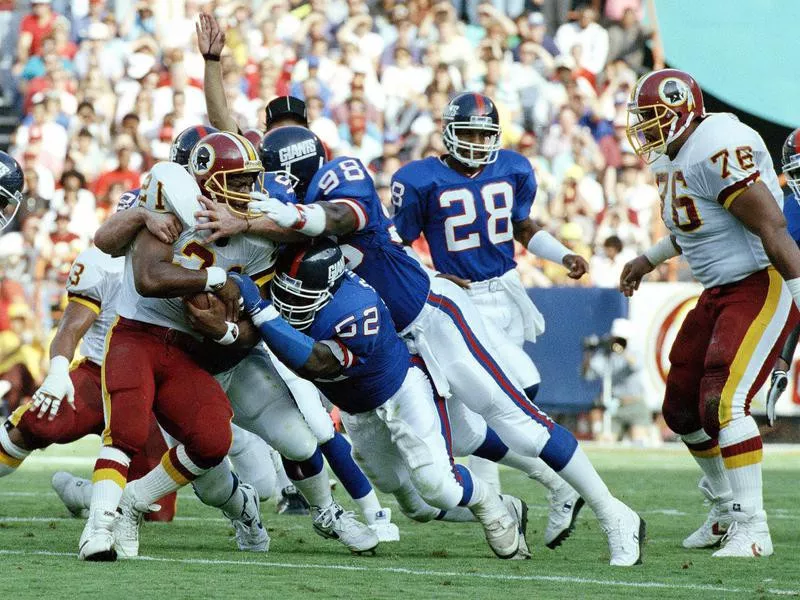
Watch and learn. Doug Mills / AP Photoo
Record: 12-4 (second, NFC East)
Points allowed: 13.2 (first)
Total yards allowed: 262.9 (second)
Rush yards allowed: 91.2 (four)
Pass yards allowed: 171.7 (sixth)
Sacks: 1.9 (24th)
Takeaways: 2.1 (eighth)
Coordinator: Bill Belichick
Notable players: Tackle Erik Howard, cornerback Iverson Walls, linebackers Pepper Johnson and Lawrence Taylor
Finish: Beat Buffalo Bills 20-19 to win Super Bowl XXV
Bottom line: At 31, L.T. no longer harassed quarterbacks like the crazed dog of younger days.
This stable bunch was long on smarts and experience, which atoned for the shortage of pass-rushers and playmakers.
Opponents had to beat them, because they wouldn’t beat themselves.
11. 2000 Baltimore Ravens
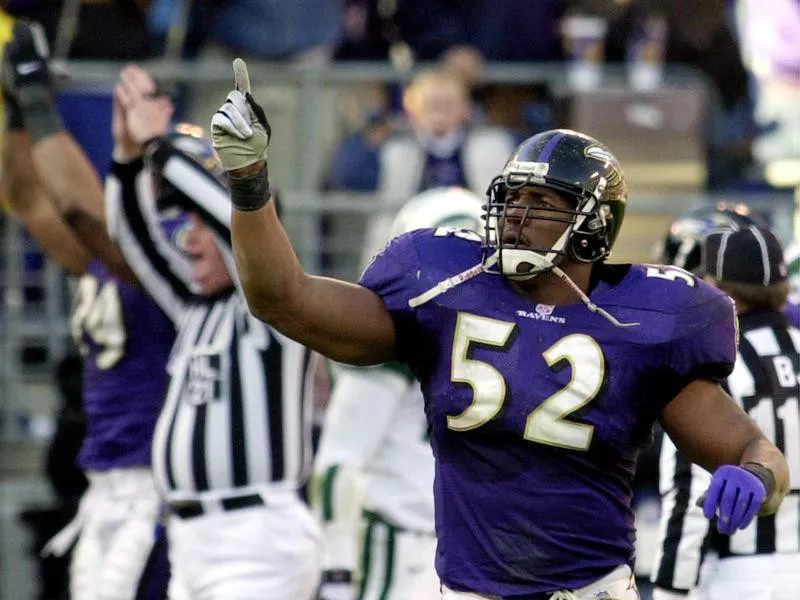
Defense first. Nick Wass / AP Photo
Record: 12-4 (second, AFC Central)
Points allowed: 10.3 (first)
Total yards allowed: 247.9 (first)
Rush yards allowed: 60.6 (first)
Pass yards allowed: 187.3 (eighth)
Sacks: 2.2 (27th)
Takeaways: 3.1 (first)
Coordinator: Marvin Lewis
Notable players: Tackle Sam Adams, end Rob Burnett, linebacker Ray Lewis, safety Rod Woodson
Finish: Beat New York Giants 34-7 to win Super Bowl XXXV
Bottom line: No defense allowed fewer points in a 16-game season.
The Raven’s followed that with a postseason performance for the ages — 23 points (two touchdowns) allowed in four games.
Yet their greatest accomplishment was this: They carried an offense with Trent Dilfer at quarterback to a Super Bowl title.
10. 1973 Miami Dolphins
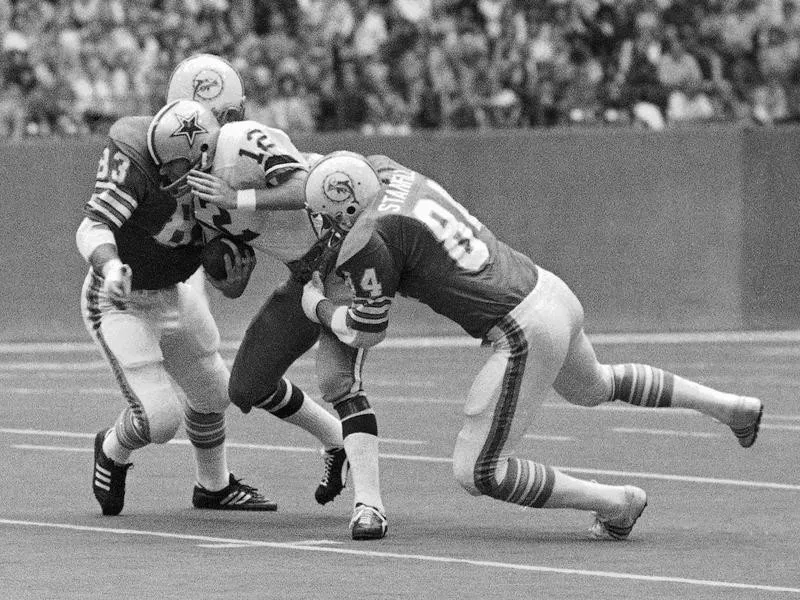
These “No Names’ could play. Harold Waters / AP Photo
Record: 12-2 (first, AFC East)
Points allowed: 10.7 (first)
Total yards allowed: 234.4 (third)
Rush yards allowed: 142.2 (12th)
Pass yards allowed: 92.1 (first)
Sacks: 3.2 (second)
Takeaways: 2.1 (22nd)
Coordinator: Bill Arnsparger
Notable players: Linebacker Nick Buoniconti, end Bill Stanfill, safeties Dick Anderson and Jake Scott
Finish: Beat Minnesota Vikings 24-7 to win Super Bowl VIII
Bottom line: This was known as the “No Name Defense,” but “No Pass” was more like it.
Consistent heat on the quarterback, coupled with stellar secondary play, limited opponents to less than 100 yards through the air per game.
Can’t think of a coach that got more out of his personnel than Bill Arnsparger did with this group.
9. 1977 Denver Broncos
Record: 12-2 (first, AFC West)
Points allowed: 10.6 (third)
Total yards allowed: 269.6 (ninth)
Rush yards allowed: 109.4 (first)
Pass yards allowed: 160.3 (25th)
Sacks: 2.5 (12th)
Takeaways: 2.8 (ninth)
Coordinator: Joe Collier
Notable players: End Lyle Alzado, safety Billy Thompson, linebackers Randy Gradishar and Tom Jackson
Finish: Lost to Dallas Cowboys 27-10 in Super Bowl 12
Bottom line: The original Orange Crush sent five players to the Pro Bowl — and tackle Rubin Carter should have been a sixth.
When opponents couldn’t run the ball, which was often, they played into the hands of an opportunistic back eight who picked off 25 passes in the regular season.
8. 1962 Detroit Lions

Fearsome defense. AP Photo
Record: 11-3 (second, NFC West)
Points allowed: 12.6 (second)
Total yards allowed: 229.8 (first)
Rush yards allowed: 87.9 (first)
Pass yards allowed: 141.9 (third)
Sacks: 4.1 (first)
Takeaways: 3.4 (third)
Coordinator: Don Shula
Notable players: Tackle Roger Brown, cornerback Dick Lane, safety Yale Lary, linebacker Joe Schmidt
Finish: Beat Pittsburgh Steelers 17-10 in NFL Playoff Bowl (third place)
Bottom line: Back when the game was my man against your man and may the best one win, this talented group created mismatches all over the field.
Four future Hall of Famers were part of the mix — Dick Lane, Yale Lary, Joe Schmidt and cornerback Dick LeBeau — and Roger Brown and sidekick Alex Karras should be in Canton with them.
Yowza.
7. 1968 Baltimore/Indianapolis Colts
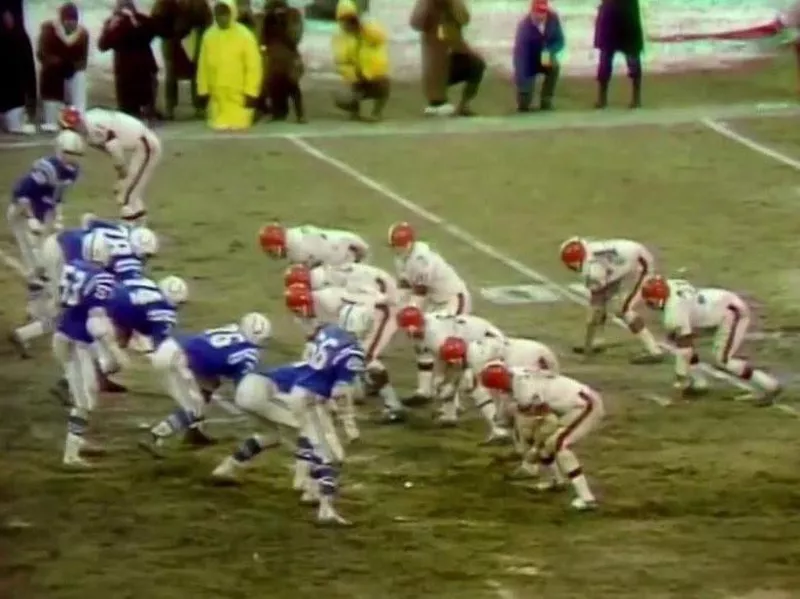
The 1968 Baltimore Colts beat the Cleveland Browns 34-0 in the NFL Championship Game to advance to Super Bowl 3. @SportsDaysPast / Twitter
Record: 12-4 (first, NFL Coastal)
Points allowed: 10.3 (first)
Total yards allowed: 241.2 (second)
Rush yards allowed: 95.6 (third)
Pass yards allowed: 145.6 (fourth)
Sacks: 3.2 (third)
Takeaways: 2.9 (fourth)
Coordinator: Head coach Don Shula
Notable players: Cornerback Bobby Boyd, linebacker Mike Curtis, tackle Billy Ray Smith, tackle Bubba Smith
Finish: Lost to New York Jets 16-7 in Super Bowl III
Bottom line: Five 30-somethings turned in remarkable performances, but did advanced age catch up with them late in the season?
Opponents had their three highest yardage totals in the final four games.
That included a Super Bowl III loss that wasn’t quite the shocker that many made it out to be.
6. 2013 Seattle Seahawks
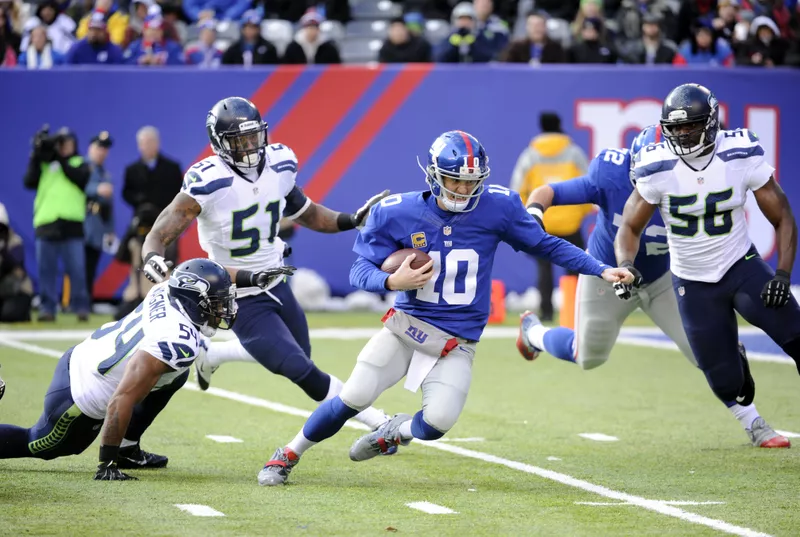
Nowhere to run. Bill Kostroun / AP Photo
Record: 13-3 (first, NFC West)
Points allowed: 14.4 (first)
Total yards allowed: 273.6 (first)
Rush yards allowed: 101.6 (seventh)
Pass yards allowed: 172.0 (first)
Sacks: 2.75 (eighth)
Takeaways: 2.4 (first)
Coordinator: Dan Quinn
Notable players: Cornerback Richard Sherman, linebacker Bobby Wagner, safeties Kam Chancellor and Earl Thomas
Finish: Beat Denver Broncos 43-8 to win Super Bowl XLVIII
Bottom line: The “Legion of Boom” may not be the best defense ever, but we’re pretty sure it’s the loudest.
It gave up 17 points or less 10 times in the regular season.
Then it reduced quarterback Peyton Manning and the Denver Broncos to a puddle in the Super Bowl XLVIII rout.
5. 1969 Minnesota Vikings
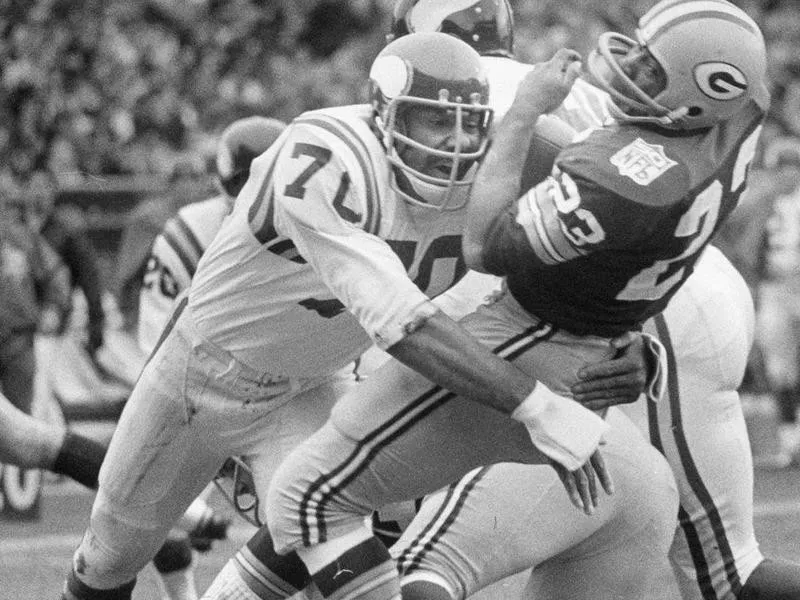
Proceed with caution. Minnesota Vikings / Facebook
Record: 12-2 (first, NFL Central)
Points allowed: 9.5 (first)
Total yards allowed: 194.3 (first)
Rush yards allowed: 77.8 (second)
Pass yards allowed: 116.5 (first)
Sacks: 3.5 (third)
Takeaways: 3.0 (second)
Coordinator: Bob Hollway
Notable players: Safety Paul Krause, tackle Alan Page, ends Carl Eller and Jim Marshall
Finish: Lost to Kansas City Chiefs 23-7 in Super Bowl IV
Bottom line: We won’t argue their complete and utter dominance in the regular season.
Overlooked is that much of it came at the expense of so many Bob Douglasses and Don Horns in a quarterback-challenged division.
The fact that it spit up 23 points against Len Dawson and the Kansas City Chiefs in Super Bowl IV takes some gloss off the shine.
4. 1975 Pittsburgh Steelers

Beware of defenders with reckless abandon and bad intentions. AP Photo
Record: 12-2 (first, AFC Central)
Points allowed: 11.6 (second)
Total yards allowed: 261.5 (fourth)
Rush yards allowed: 130.4 (eighth)
Pass yards allowed: 131.1 (fourth)
Sacks: 3.1 (fifth)
Takeaways: 2.6 (13th)
Coordinator: Bud Carson
Notable players: Cornerback Mel Blount, tackle Joe Greene, linebackers Jack Ham and Jack Lambert
Finish: Beat Dallas Cowboys 21-17 to win Super Bowl X
Bottom line: For extended dominance, our money is on the “Steel Curtain” as the greatest defense of all time. This edition featured eight Pro Bowl selections, for gosh sakes.
In the postseason, Pro Bowl candidate Bert Jones and future Hall of Famers Ken Stabler and Roger Staubach could produce only 12.3 points and 154.0 pass yards per game against them.
The Steel Curtain peaked the next season, when it pitched an insane five shutouts, three of them in succession. It was so dadgum dominant that the no-chuck rule was adopted one year later.
3. 2002 Tampa Bay Buccaneers
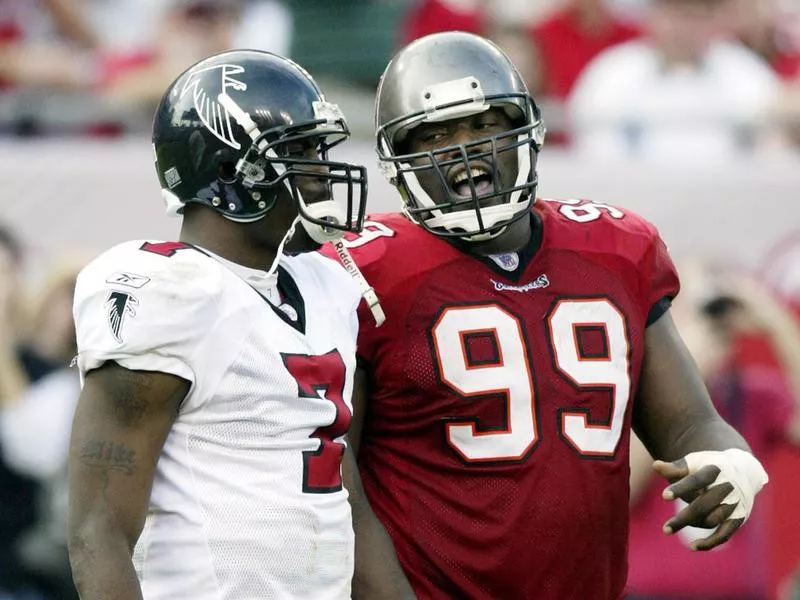
The 2002 Buccaneers talked the talk and walked the walk. Scott Audette / AP Photo
Record: 12-4 (first, NFC South)
Points allowed: 12.3 (first)
Total yards allowed: 252.75 (first)
Rush yards allowed: 97.1 (fifth)
Pass yards allowed: 155.6 (first)
Sacks: 2.7 (sixth)
Takeaways: 2.4 (third)
Coordinator: Monte Kiffin
Notable players: Cornerback Ronde Barber, linebacker Derrick Brooks, end Simeon Rice, tackle Warren Sapp
Finish: Beat Oakland Raiders 48-21 to win Super Bowl XXXVII
Bottom line: What happens when you combine a newfangled scheme (Tampa 2) with as many as four future Hall of Famers in their primes? Greatness happens.
This group allowed 12.3 points per game in the regular season, 12.3 per game in the playoffs.
All it lacked was a cool nickname.
2. 1963 Chicago Bears
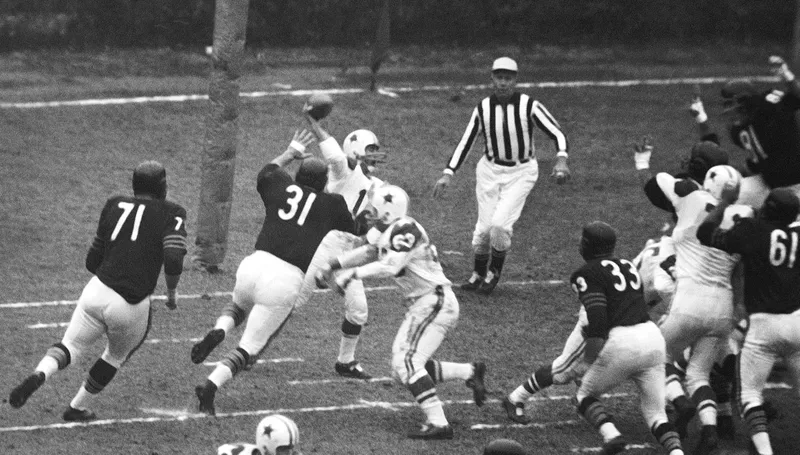
Beware of Bears. Ed Maloney / AP Photo
Record: 11-1-2 (first, NFL West)
Points allowed: 10.3 (first)
Total yards allowed: 226.9 (first)
Rush yards allowed: 103.0 (first)
Pass yards allowed: 123.9 (first)
Sacks: 2.6 (seventh)
Takeaways: 3.9 (first)
Defense assistant: George Allen
Notable players: End Doug Atkins, linebacker Joe Fortunato, safeties Richie Petitbon and Rosey Taylor
Final: Beat New York Giants 14-10 to win NFL championship
Bottom line: Shocker! You thought the Da ’85 Bears would be here, didn’t you? Well, Da ’63 Bears were a tad better.
This curious mix of grizzled veterans up front and young, athletic playmakers in the secondary were an ideal combo for the Allen-concocted blitzes that had opponents in a tizzy.
His guys allowed as many as 17 points only twice in the regular season, then bludgeoned quarterback Y.A. Tittle and the New York Giants in the championship game.
1. 1962 Green Bay Packers
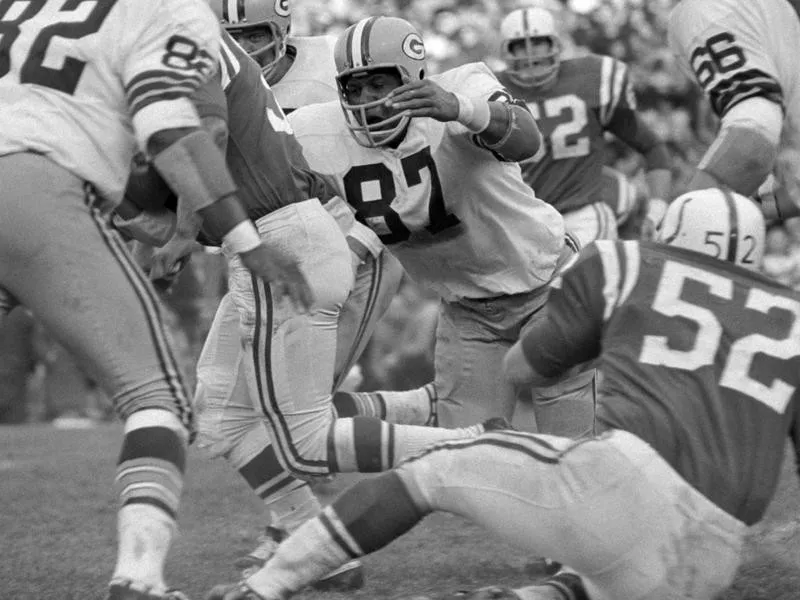
The best of the best. Playball Ink / Facebook
Record: 13-1 (first, NFL West)
Points allowed: 10.6 (first)
Total yards allowed: 234.1 (second)
Rush yards allowed: 109.4 (fifth)
Pass yards allowed: 124.7 (first)
Sacks: 3.0 (fifth)
Takeaways: 3.6 (first)
Coordinator: Phil Bengston
Notable players: Cornerback Herb Adderley, end Willie Davis, linebacker Bill Forester, tackle Henry Jordan
Finish: Beat New York Giants 16-7 to win NFL championship
Bottom line: Here’s why.
Leadership: Vince Lombardi was the head coach. Perhaps you’ve heard of him.
Physical talent: The lineup featured five future Hall of Famers, all in their primes. Nine starters would make multiple Pro Bowl appearances in their careers.
Experience: Nine starters had been in the league at least three seasons.
Continuity: This marked the third season of the Lombardi era, and all except Herb Adderley and safety Willie Wood had been together from the get-go. Only two starters sat out for a total of five games this season.
Achievement: Fifteen games, 14 touchdowns allowed, three shutouts. In the league championship game, the top-ranked New York Giants offense was held without a point. At home.
Now what do you say?